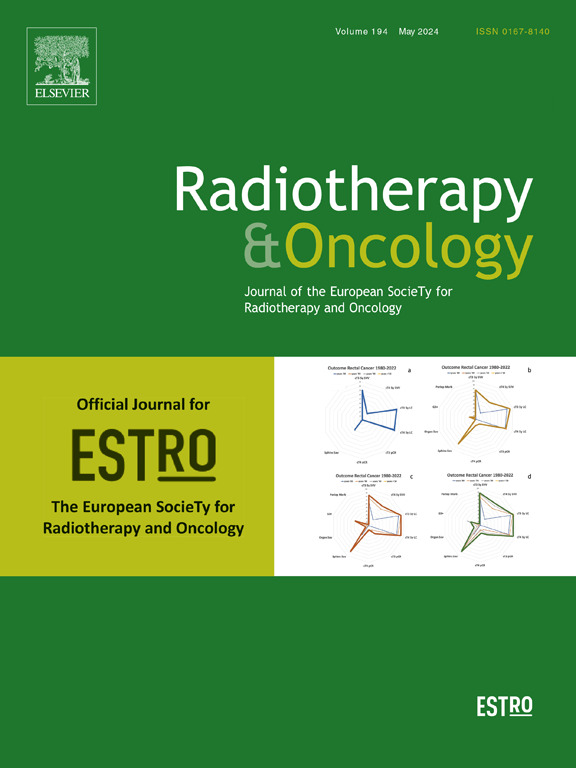Improved NTCP model for late radiation-induced aspiration based on dose delivered to specific aspiration-related OARs
IF 4.9
1区 医学
Q1 ONCOLOGY
引用次数: 0
Abstract
Background and purpose
Radiation-induced aspiration is a serious complication following (chemo)radiation for head and neck cancer. The standard set of swallowing organs at risk (SWOARs) does not include all aspiration-related organs (OARs). An alternative proposed in earlier work includes a definition and delineation atlas for additional OARs, called Functional Swallowing Units (FSU). The purpose of this study was to compare two NTCP models for late aspiration, based on either SWOARs only or the FSU concept.
Methods and materials
Data from 189 patients were analysed. Aspiration at baseline (Asp_T0) and 6 months after treatment (Asp_T6) were scored according to Penetration Aspiration Scale (PAS). All SWOARs and FSUs were delineated and the DVH was recorded. Clinical factors and average dose (Dmean) to all aspiration-related OARs were included in multivariable analysis. Two models were built, model 1: including clinical factors and SWOARs only and model 2: including clinical factors, SWOARs and FSUs.
Results
Both final models included Asp_T0 and Dmean to the supraglottic larynx as predictors. Model 2 included the dose to three additional OARs as a predictor: 1) Anterior Segment (floor of mouth/ thyrohyoid muscles) 2) hyoglossus/styloglossus muscles complex (HSG) 3) upper oesophageal sphincter (UES). Adding FSUs to model 1 resulted in significant model updates and model 2 performed better than model 1 (AUC 0.79 vs. 0.75).
Conclusion
NTCP models for late aspiration may be improved by including the dose to aspiration-related OARs, defined by the FSU concept. In addition to the supraglottic larynx, sparing of the Anterior Segment, HSG and UES could further decrease the risk of radiation-induced aspiration, but this remains to be confirmed in clinical studies.
基于特定吸入相关桨叶的剂量,改进的晚期辐射诱导吸入NTCP模型。
背景与目的:放射诱导误吸是头颈癌化疗后的严重并发症。标准的危险吞咽器官(swars)不包括所有与吸入相关的器官(OARs)。在早期的工作中提出的另一种选择包括附加桨的定义和描绘图谱,称为功能吞咽单元(FSU)。本研究的目的是比较两种基于swars和FSU概念的晚期误吸NTCP模型。方法与材料:对189例患者的资料进行分析。根据穿透吸吸量表(PAS)对基线吸吸(Asp_T0)和治疗后6 个月(Asp_T6)进行评分。所有患者均进行了swars和FSUs的圈定,并记录了DVH。多变量分析包括临床因素和所有吸入相关OARs的平均剂量(Dmean)。建立两个模型,模型1:仅包括临床因素和swars,模型2:包括临床因素、swars和FSUs。结果:两种最终模型均以声门上喉的Asp_T0和Dmean作为预测因子。模型2包括三个额外的OARs的剂量作为预测因子:1)前段(口底/甲状舌骨肌)2)舌舌肌/茎突舌肌复合体(HSG) 3)食管上括约肌(UES)。在模型1中加入fsu导致了显著的模型更新,模型2的表现优于模型1 (AUC 0.79 vs. 0.75)。结论:通过纳入FSU概念定义的吸入相关OARs的剂量,可以改进NTCP晚期吸入模型。除声门上喉外,保留前段、HSG和UES可进一步降低辐射诱导误吸的风险,但这有待临床研究证实。
本文章由计算机程序翻译,如有差异,请以英文原文为准。
求助全文
约1分钟内获得全文
求助全文
来源期刊

Radiotherapy and Oncology
医学-核医学
CiteScore
10.30
自引率
10.50%
发文量
2445
审稿时长
45 days
期刊介绍:
Radiotherapy and Oncology publishes papers describing original research as well as review articles. It covers areas of interest relating to radiation oncology. This includes: clinical radiotherapy, combined modality treatment, translational studies, epidemiological outcomes, imaging, dosimetry, and radiation therapy planning, experimental work in radiobiology, chemobiology, hyperthermia and tumour biology, as well as data science in radiation oncology and physics aspects relevant to oncology.Papers on more general aspects of interest to the radiation oncologist including chemotherapy, surgery and immunology are also published.
 求助内容:
求助内容: 应助结果提醒方式:
应助结果提醒方式:


